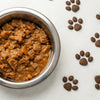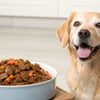Can Wet Food Give Dogs Diarrhea? Understanding the Impact of Wet Dog Food on Canine Digestion
- Houndsy
Table of Contents
- Introduction
- The Basics of Dog Digestion
- Common Causes of Diarrhea in Dogs
- Can Wet Food Specifically Trigger Diarrhea?
- Signs Your Dog's Diarrhea May Be Food-Related
- Managing Dietary Transitions
- The Role of High-Quality Wet Food
- Conclusion
Introduction
As loving pet owners, we know the joys of watching our dogs indulge in their meals. The wagging tails, the excited barks, and the satisfaction of knowing we are nourishing them create a beautiful feeding ritual. But amidst this daily delight, a concern that might cross our minds is: can wet food give dogs diarrhea?
While many of us associate wet dog food with delicious flavors and hydration, it's essential to consider how it may affect our furry friends' digestive systems. Studies have indicated that certain dietary factors can impact dogs' gastrointestinal health, and transitioning diets—especially from dry to wet food—can induce changes in stool consistency.
In this blog post, we will explore the relationship between wet dog food and diarrhea, providing you with evidence-based insights and practical advice for managing your dog's diet effectively. We’ll delve into the nuances of dog digestion and nutritional needs, helping you make informed decisions about feeding practices that ensure your pet’s health and enjoyment.
By the end of this comprehensive guide, you’ll have a clearer understanding of whether wet food might be the culprit behind your dog’s digestive distress and how we, at Houndsy, can help support your feeding journey with our innovative products.
The Basics of Dog Digestion
Understanding Canine Digestion
To comprehend the potential impact of wet food on your dog’s digestive health, let's start with some foundational concepts. A dog's digestive system is intricately designed, capable of processing a variety of food types. The stomach, enzymes, and gut bacteria all work together to break down food into nutrients that the body can absorb.
- Mouth and Saliva: Chewing begins the digestion process, while saliva contains enzymes that help break down carbohydrates.
- Stomach: Acidic gastric juice further breaks down food, making it easier for the intestines to absorb nutrients.
- Small Intestine: The majority of nutrient absorption occurs here, assisted by bile from the liver and enzymes from the pancreas.
- Large Intestine: Water reabsorption occurs here, and remaining waste is prepared for excretion.
Understanding this system highlights how a sudden change in diet, such as introducing wet food, might affect your dog's stools.
Why Would a Sudden Change in Diet Affect Stools?
- Adaptation Period: Dogs may take time to adjust to new foods, and during this period, fluctuations in stool consistency can occur.
- Sensitivity to Ingredients: Some dogs may be sensitive or allergic to specific wet food ingredients, leading to gastrointestinal upset and diarrhea.
- Moisture Content: Wet food has a higher moisture content than dry food, which may affect stool consistency. For example, the incorporation of wet food into a dog’s diet can lead to looser stools simply due to increased moisture.
Recognizing these factors can help us pinpoint whether wet food might be the reason behind any digestive issues, including diarrhea.
Common Causes of Diarrhea in Dogs
Understanding other potential causes of diarrhea helps clarify if wet food is the primary factor. Diarrhea in dogs can arise from various scenarios, including:
- Dietary Changes: Transitioning between food types too quickly can disturb the gastrointestinal tract.
- Food Allergies or Intolerances: Dogs may be allergic to specific proteins or fillers commonly found in wet food.
- Infections: Bacterial, viral, or parasitic infections can lead to gastrointestinal disturbances.
- Dietary Indiscretion: Many dogs are notorious for scavenging, which can introduce harmful substances to their systems.
- Stress: Emotional stress from changes in the environment can also affect digestive health.
By understanding these potential causes, we can differentiate between normal digestive adjustments and concerning symptoms that warrant veterinary attention.
Can Wet Food Specifically Trigger Diarrhea?
The Relationship Between Wet Food and Digestion
While wet food alone doesn't directly cause diarrhea, certain conditions may activate this response. The quality of wet food is central to this discussion. It’s crucial to select high-quality brands that don't contain fillers, artificial additives, or excessive fat, as these ingredients can upset a dog's digestive system.
It's also essential to transition gently to new foods, including wet varieties. Ideally, we should mix the new wet food with the dog’s current diet gradually over several days to allow their digestive system to acclimatize.
Wet Food as a Potential Trigger
- Ingredient Sensitivities: If your dog reacts negatively to specific proteins or ingredients, wet food containing these could cause diarrhea.
- Preservatives and Additives: Some wet foods have preservatives; if your dog reacts poorly to these, it could lead to gastrointestinal issues.
- Excess Moisture: An abrupt increase in water intake (from wet food) can lead to looser stools, especially if the dog's previous diet was primarily dry.
Signs Your Dog's Diarrhea May Be Food-Related
When monitoring your dog for signs of diarrhea, look for the following symptoms that may indicate a dietary connection:
- Loose or Watery Stools: Pay attention to the frequency and consistency of bowel movements.
- Vomiting: Accompanying vomiting may indicate dietary intolerance or other gastrointestinal issues.
- Loss of Appetite: Refusal to eat may signal that the current diet is causing discomfort.
- Abdominal Discomfort: Signs such as bloating, gas, and groaning can suggest digestive distress.
If your dog exhibits any of these symptoms, it may be time to examine their current diet.
Managing Dietary Transitions
Gradual Changes to Prevent Digestive Upset
To minimize gastrointestinal disturbances when changing your dog’s diet, we recommend the following steps:
- Slow Transition: Introduce new wet food gradually, starting with a small proportion mixed with their current food, and increase the amount over 5-7 days.
- Observation: Monitor for any signs of diarrhea or discomfort, adjusting the transition as needed.
- Hydration Access: Ensure your pet always has access to fresh water, as diarrhea can lead to dehydration.
- Consult a Vet: If diarrhea persists beyond a couple of days, consult your veterinarian for guidance.
The Role of High-Quality Wet Food
Choosing the Right Wet Dog Food
When it comes to wet dog food, not all products are created equal. To promote optimal digestion, consider the following tips:
- Check Ingredients: Look for high-quality, identifiable ingredients with single sources of protein and no fillers.
- Consider Probiotics: Select wet food formulations that include probiotics to support digestive health.
- Nutritional Balance: Ensure the food meets AAFCO standards for balanced nutrition appropriate for your dog’s life stage.
At Houndsy, we pride ourselves on offering only the best. Our Houndsy Kibble Dispenser is designed to provide consistent, perfectly portioned meals without the hassle of natural mess. Our products exemplify our commitment to enhancing the feeding experience for dogs—demonstrating that great design and functionality can coexist beautifully in a home.
Discover more about how our dispenser ensures that you do not have to compromise on portion control or aesthetic, check our Houndsy Kibble Dispenser.
Conclusion
In summary, while wet food itself does not inherently cause diarrhea in dogs, it’s important to be mindful of dietary changes, ingredient sensitivities, and the quality of food. By understanding this intricate balance, you can make informed choices that enhance your dog's feeding experience while prioritizing their health.
Should you experience ongoing issues with diarrhea, always consult with a veterinarian to explore underlying conditions and necessary dietary adjustments. Embrace the joy of feeding your dog in a way that's tailored to their unique needs, and trust that we at Houndsy are here to support you with products designed to elevate the feeding ritual.
FAQ
1. Can I feed my dog wet food exclusively?
Yes, many dogs thrive on a wet food diet, especially if it meets their nutritional needs. However, ensure it’s high-quality and suitable for their life stage.
2. How can I tell if my dog has a food sensitivity?
Watch for recurring symptoms such as diarrhea, vomiting, or excessive itching after meals. Keeping a food diary can help identify patterns.
3. What should I do if my dog has diarrhea?
If your dog has diarrhea but is otherwise healthy, withhold food for 12–24 hours, providing water. If diarrhea persists or is accompanied by other symptoms, consult your veterinarian.
4. Is it safe to mix wet and dry food?
Yes, mixing wet and dry food can provide variety and cater to your dog’s preferences. Just monitor for any digestive upset during the transition.
5. What’s the best way to transition to wet food?
Gradually introduce wet food by mixing it with existing food, slowly increasing the ratio of the new food over a week to prevent gastrointestinal issues.
Maintain a hopeful outlook that by attentively managing your dog’s diet and utilizing high-quality products, both their feeding experience and digestive health can be beautifully synchronized.













